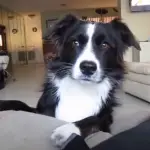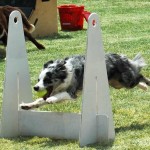New Year’s Resolution: A Healthier Dog
Some of our everyday tricks make for a great workout and, given the cold and inclement weather outside, you’ll be happy to hear that there’s plenty you can do inside!
Indoor Activities
“Take a Bow” or “Downward Dog” (a “doga” pose)
The bow (front legs on the floor, standing on back legs) is a natural stretch, one that dogs will often do when they first rise from a nap. It’s a great way to start out an exercise session. Some dogs will easily go into a bow position by luring as if for a “down” but doing it from a stand rather than from a sit. Other dogs go directly to the down, whether from sit or stand. If this is the case, then you’ll have to shape the behavior. Starting from a stand, take the lure just a few inches below your dog’s nose level, so that he has to tuck his neck down a bit to follow the lure. Say “Yes!” and treat. When this is repeatable, try moving your hand a few inches lower but still not entirely to the ground. Again your dog will hopefully tuck his head even lower but remain standing. If he flops down to the floor, then go back to your previous stage and inch down the hand signal more gradually. At each stage where he’s tucking his head, maybe even bending the front legs, but remain on his back legs, say “Yes!” and give a treat. Even jackpot him for each new criteria he achieves. Before you know it, your dog will be bowing pretty as can be!
Tug
Tug is no doubt one of your dog’s favorite pastimes! Fortunately, it’s a great strength-building exercise as well as a fun bonding activity that we can do with our dogs. By holding the tug at head level, your dog is working out his rear legs. By tugging at ground level, he’s working out his front legs. Caution: It’s important that you do not jerk the tug toy quickly from side to side or up and down, as this can cause injury.
VARIATIONS ON SHAKE
Shake
"Shake" is more than just a trick. It helps your dog get more comfortable with people touching his paws. It’s also a great strengthening exercise for your dog’s shoulders. With your dog in a sit, hold a treat above his head and off to one side. By rocking him to the side, often he will pick up the opposite front paw to reach for it. Mark it with a happy “yes!”, grab the paw with your other hand, and open the treat hand to reveal the treat. After he is consistently offering a paw, say the verbal command “shake” or “give paw” in front of it. By switching sides, you can train a “left paw” and “right paw” behavior.
Srength training
Once your dog has gained fluency, give the hand cue from higher up so that he has to lift his paw higher. Start with 5 repetitions each side and gradually increase to 20 repetitions, cuing from both the front and the side. Do this exercise every other day, with the day off in between to allow the muscles to mend.
High 5
Just change the position of your hand so that it’s ready to receive a “high 5” when your dog does the “shake” behavior.
Wave
Now give the cue for “shake” but instead of keeping your hand stationary to receive your dog’s paw, move it horizontally in front of him. This will cause him to lift his paw a little longer and perhaps even make another swipe to meet your hand. Especially reinforce the extra jabs in the air.
Back Up
Backing up is a great workout for the core and hind leg muscles. The easiest way to shape the back-up behavior is to hold a treat at the level of your dog’s chest with you facing him and then walk towards him. Let him nibble the treat along the way to keep him interested and playing the game. As he becomes more fluent, you can reduce the physical cueing necessary to effect the behavior.
Sit-Stand-Sit
The rear legs are often the first to weaken as your dog ages, so it’s important that you keep them strong. Moving your dog between a sit and stand can accomplish this. By holding a treat above your dog’s nose and moving it back over his head, you effectively push his butt down into the sit position. Now put the treat at nose level and pull it forward just enough to lure your dog to a stand in a single step. You want him to be pushing off with his rear legs for maximum benefit and not pulling himself forward with his front legs. Note: If your dog uses more than a single step to rise to a stand, it’s likely that he’s used his front legs rather than his hind legs.
For a greater workout, do this while facing uphill. Alternatively, face sideways on the hill, first one way, then the other, to target each side individually. Start with 3 to 5 repetitions, then gradually increase to 10 or 20 repetitions. Do this exercise every other day, with the day off in between to allow the muscles to mend.
Stand-Down-Stand
Moving from a stand to a down and back again is a great workout for the whole body. Hold a treat at your dog’s nose and push back and down, causing him to fold into the down position. Now put the treat at nose level and pull it forward just enough to lure your dog to a stand without moving forward.
As with the Sit-Stand-Sit exercise, increase the difficulty of this exercise by doing it while facing uphill, or by facing sideways on the hill, first one way, and then the other, to target each side individually. Start with 3 to 5 repetitions, then gradually increase to 10 or 20 repetitions. Again, allow a day in between for recuperation.
Rollover
For the benefit of working your dog’s core muscles, do this exercise in both directions. Once in a “down” position, notice which hip your dog is settled on. Lure his nose around the opposite shoulder and, as he twists his neck, he will roll first flat, then on his back, and then onto the other side. If he has trouble doing the whole movement right away, reinforce approximations. For greater challenge, do several rollovers in one direction, then back in the other direction, or do the rollover up an incline.
Sit Pretty
Sitting pretty is a great workout for the core muscles and aids balance. From a sitting position, lure your dog into a beg position by pulling a treat back and above his nose. As he becomes more fluent with the behavior, start putting the verbal cue in front of the hand signal. Build duration in the time he remains in position. For increased difficulty, cue him to give left paw, right paw, or both paws at once. Also lure him to turn his head and upper body by leading his nose with a treat, first one way, and then the other.
Crawl
The crawl is great for working out a dog’s forelimbs, trunk and rear limbs. From a “down” position, drag a treat along the floor just in front of your dog’s paws. Mark and treat for any slight forward movement with a paw. Gradually start to mark for more and more movement forward (as long as your dog never stands up to come forward). When your dog is fluently offering the behavior, put the verbal cue “crawl” in front of the hand signal. To encourage crawling, you can use props such as a low table or poles across chairs. You can increase the distance of the obstacle course or the number of repetitions as your dog gains endurance.
Spin
“Spin” is a proprioceptive exercise, one that challenges body awareness through limb placement and balance. With your dog in front of you, hold a treat at your dog’s nose height. Lead him around in a tight circle, first in one direction, then the other. If you’d like, you can precede the hand prompt with the verbal cue “spin!” once the behavior is coming fairly fluently. To increase its benefit, this is an exercise you can do on a variety of surfaces, such as gravel and grass.
Outdoor Activities
Digging
Some dogs are unabashed diggers. The dachshund, for example, was bred to dig in search of rodents. Digging is actually a good source of exercise – it’s a great workout for the forelimbs. So, rather than trying to inhibit the behavior completely, it’s better to reach a compromise by giving your dog a designated digging area or sandbox in which to exercise this instinctive behavior. In order to attract the behavior to the designated area, dig a shallow hole and lightly bury a Ziploc baggy of treats. As he digs to reveal the baggy, open it up and produce a treat for him. As he progresses, plant the baggy slightly deeper in the dirt. You can use a heavier dirt medium or pack it more tightly for added challenge.
You can also bury stuffed puzzle toys in the soil for his search and recovery. Make sure to supervise so that you can discourage your dog’s wandering to other parts of the lawn. For building a canine athlete, do this exercise 3 or 4 times a week.
Retrieve
Playing a hearty game of retrieve has always been great exercise. You can expand on its efficacy by throwing uphill to work your dog’s hind limbs, and retrievals through water are a great full-body endurance workout.
Walkies!
Taking your dog for a walk is not necessarily beneficial if the walk is a slow saunter as he sniffs p-mail and leaves his own. In order to get cardiovascular benefit and build endurance, you want your dog to settle into a trot gait. Start your walk at a clip fast enough so that your dog needs to trot to keep up. After he’s settled into this gate, you can often slow your own speed and he will continue on at a trot.
Canine Sports
Sports such as agility, flyball, and winter skijoring are great sources of exercise for dog and human alike. Consider signing up for a class at a local training facility.
A Word to the Wise
Remember that outdoor activity is still an essential component of any exercise regimen, giving your dog a change of scenery, which is mentally stimulating, as well as burning physical energy. Consider your dog’s athletic program with the same caution and care as you would your own. As with any exercise regimen, start gradually. And consult your vet about whether there are exercises you should avoid because of your dog’s physical limitations.
Have a healthy, happy New Year!
Article By:
Laura Garber






